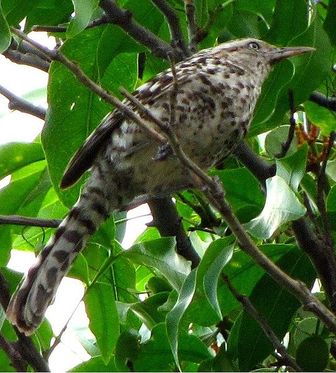Stripe-backed Wren
The Stripe-backed wren has attracted considerable scientific attention because it is a good example of co-operative breeding. It lives in groups ranging from 2 to 10 adult birds. Of these, only one pair breeds, laying eggs at the beginning of the rainy season . However all members of the group participate in defence of the territory, and in feeding the young both in the nest and after fledging. They therefore qualify as helpers at the nest.

Original source: Campylorhynchus_nuchalis_brevipennis_1.jpg: Cristóbal Alvarado Minic from Cagua, Venezuela
Author: Campylorhynchus_nuchalis_brevipennis_1.jpg: Cristóbal Alvarado Minic from Cagua, Venezuela
The Stripe-backed Wren is classified as Least Concern. Does not qualify for a more at risk category. Widespread and abundant taxa are included in this category.
The Stripe-backed Wren, Campylorhynchus nuchalis, is a bird found in the savannas of northern Colombia and central Venezuela. It lives in dry, riparian woodland, or farmlands, and is found at heights up to 800 m. The Stripe-backed wren has attracted considerable scientific attention because it is a good example of co-operative breeding. It lives in groups ranging from 2 to 10 adult birds. Of these, only one pair breeds, laying eggs at the beginning of the rainy season (May to September). More
Stripe-backed Wren Campylorhynchus nuchalis = Described by: Cabanis (1847) Alternate common name(s): Stripe-backed Cactus-wren, Banded Wren Old scientific name(s): None known by website authors Photographs Orinoco River Delta, Venezuela - Jan 15, 2007 More
Each family of stripe-backed wrens consists of a principal male and female (mother and father) More
Some of the calls of Stripe-backed Wrens show individual variations that are consistent from father to son. This is a potential example of the formation of a dialect in bird song. The distinctive family calls seem to be used to maintain social contact between members of the co-operatively breeding group. The Stripe-backed Wren shows no sexual dimorphism (visual physical differences between the sexes) in appearance. Copyright: Wikipedia. More
Stripe-backed Wren Campylorhynchus nuchalis = Orinoco River Delta, Venezuela - Jan 15, 2007 More
Stripe-backed Wren / Common Ground Dove / Giant Hummingbird / Blue-crowned Motmot / Little Tinamou / Rufous-vented Chachalaca / Rufous-tailed Jacamar / Channel-billed Toucan / Black-faced Antthrush / Bearded Bellbird / Blue-backed Manakin / Lance-tailed Manakin / Russet-throated Puffbird / Horned Screamer / More Birds of Colombia... More
These are stripe-backed wrens, a species common throughout the llanos of Colombia and Venezuela. Two neighboring groups are fighting over the common boundary of their territories. Choosing our steps carefully, we move in for a closer look. The owner of Hato Masaguaral, Tom More
example, instead of depending upon sight, the stripe-backed wren has evolved the ability to recognize other wrens by their songs. I'm Jim Metzner, and this is the Pulse of the Planet. Jordan Price is with the Bell Museum of Natural History at the University of Minnesota. "Humans - we're very visual animals. You know, years later you can remember the way somebody looks... but voices, we're not as good at. More
The bloodlines of stripe-backed wrens can be identified by their distinct repertoire of songs. - Transcript: music ambience stripe backed wren "way" song Mr. Wren, I presume? We're listening to the "way call" of a stripe backed wren. Biologists in Venezuela have discovered that these calls are passed down from generation to generation, much like a human surname. I'm Jim Metzner, and this is the Pulse of the Planet. More
Stripe-backed Wren (Campylorhynchus nuchalis) by Chris Parrish. More
Family : Troglodytidae
Genus : Campylorhynchus
Species : nuchalis
Authority : Cabanis, 1847
